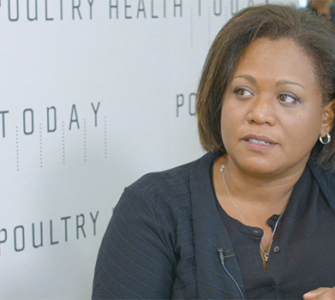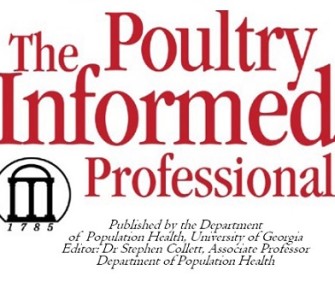Control of avian mycoplasmosis
By Naola Ferguson-Noel
Poultry Diagnostic and Research Center, Department of Population Health
University of Georgia, Athens, GA
The pathogenic avian Mycoplasma spp. (M.gallisepticum, M.synoviae, M.meleagridis and M.iowae) have been negatively affecting commercial poultry production for many years. The poultry industry and scientific community have made great strides in increasing the knowledge of the biology of these bacteria (and hence their control) since they were first identified, but much is still to be revealed.
Avian mycoplasma can evolve rapidly and strains can vary widely in virulence. Despite the current information and control options available, costly outbreaks of avian mycoplasmosis continue to occur throughout the world and the varied effects of mycoplasma on poultry production continue to be identi-fied and described.
The current approaches to MG and MS control include continuous surveillance and quarantine, medica-tion, vaccination and/or elimination of infected breeding flocks. To maintain mycoplasma-free flocks it is important to use only negative replacements, use single age farms (isolated if possible), depopulate and disinfect between flocks, maintain good biosecurity and set up monitoring program.
Elimination of a positive breeder flock is the surest way to eliminate the shed of MG or MS, but this is not always feasible. Positive flocks should be isolated as much as possible; the eggs and chicks should also be segregated. The presence of persistently infected populations (e.g. backyard birds) ensures that the biosecurity of surrounding flocks is continually challenged. In situations where negative flocks can-not be adequately isolated and positive flocks cannot be eliminated, medication and vaccination become options for mycoplasma control.
The development of antibiotic resistance, cost, regulations and feasibility limit the ability of producers to continuously apply antibiotics. Antibiotics have been used to prevent mycoplasma infection, reduce shed of the organisms (vertically and horizontally) and treat clinical signs. However, vaccination has better prospects as a long-term control method when positive flocks cannot be eliminated.
So the question is – do mycoplasma vaccines work? And the answer – yes, no or sometimes – depends on how success or failure is judged. It is important to understand the characteristics and limitations of the different vaccines and select the safest and/or most efficacious vaccine based on the specific situation and primary concerns – whether they be preventing clinical signs, protecting progeny, or avoiding vac-cine transmission to neighboring flocks.
Most of the currently available mycoplasma vaccines can prevent or reduce clinical signs (depending on the severity of challenge)(2, 6). The vaccines do vary in their safety and efficacy (1, 3). In the event of challenge with a very virulent field strain the most efficacious vaccine available would be necessary, whereas in a low challenge situation this vaccine may be excessive.
The general health of the birds is a factor in the choice of vaccine, especially in flocks that are under heavy challenge from virulent respiratory viruses or severely immunosuppressed, a safer vaccine would be preferable to a more efficacious vaccine with some reactivity.
Some vaccines can also prevent infection with and reduce transmission of a field strain (4, 5). The vaccines vary in this ability and if the main goal of the vaccination program is to eventually displace and eliminate a virulent wild-type, then a more efficacious vaccine that prevents the field strain from continuing to circulate would be important.
Another aspect of vaccination that must be taken into consideration is handling and application – a vaccine cannot be expected to behave optimally if it is mishandled. It is difficult to estimate how many “vaccine failures” in the field are actually due to improper handling or application so that the birds do not receive a protective dose and are in fact never truly vaccinated.
References
1. Abd-el-Motelib, T.Y., and S.H. Kleven. A comparative study of Mycoplasma gallisepticum vaccines in young chickens. Avian Diseases 37:981-987. 1993.
2. Evans, R.D., and Y.S. Hafez. Evaluation of a Mycoplasma gallisepticum strain exhibiting reduced virulence for prevention and control of poultry mycoplasmosis. Avian Diseases 36:197-201. 1992.
3. Ferguson-Noel, N., K. Cookson, V. Laibinis, and S.H. Kleven. The Efficacy of Three Commercial Mycoplasma gallisepticum Vaccines in Laying Hens. Avian Diseases 56:272-275. 2012.
4. Kleven, S.H., H.-H. Fan, and K.S. Turner. Pen trial studies on the use of live vaccines to displace virulent Mycoplasma gallisepticum in chickens. Avian Diseases 42:300-306. 1998.
5. Turner, K.S., and S.H. Kleven. Eradication of live F strain mycoplasma gallisepticum vaccine using live ts-11 on a multiage commercial layer farm. Avian Diseases 42:404-407. 1998.
6. Whithear, K.G., Soeripto, K.E. Harrigan, and E. Ghiocas. Immunogenicity of a temperature sensitive mutant Mycoplasma gallisepticum vaccine. Aust Vet J 67:168-174. 1990.
Fig 1 and 2
Efficacy of M.gallisepticum vaccines. Groups of broiler-type (Fig 1) or layer-type (Fig 2) chickens were vaccinated with the MG vaccine indicated and challenged with the virulent R-strain of M.gallisepticum. Air sac lesions were grossly scored (0 to 4 scale) at necropsy 10 days post challenge.

Fig 1 – Generated from “A comparative study of Mycoplasma gallisepticum vaccines in young chick-ens.” Abd-el-Motelib, T. Y., and S. H. Kleven. Avian Diseases 37:981-987. 1993.

Fig 2 – Generated from “The Efficacy of Three Commercial Mycoplasma gallisepticum Vaccines in Laying Hens.” Ferguson-Noel, N., K. Cookson, V. Laibinis, and S.H. Kleven. Avian Diseases 56:272-275. 2012.
Article from The Poultry Informed Professional, Issue 132 March/April 2014.
Published by the Department of Population Health, University of Georgia
Editor: Dr Stephen Collett, Associate Professor
Posted on August 4, 2014
















